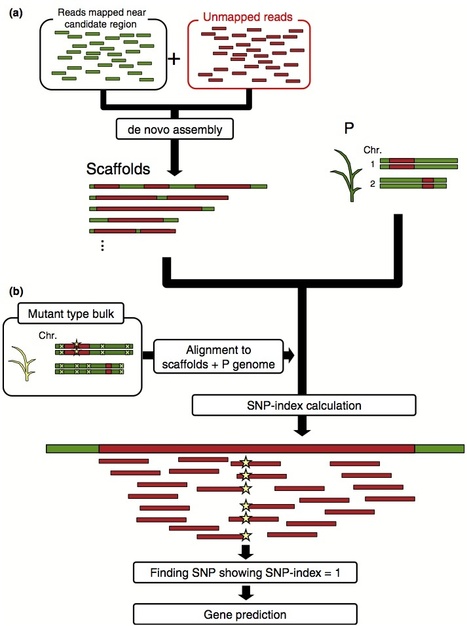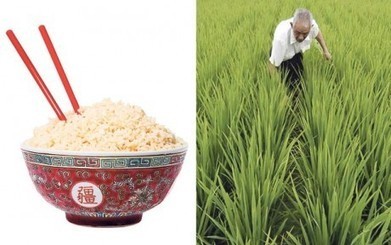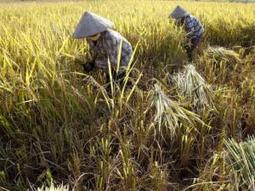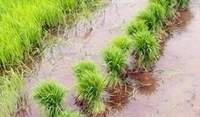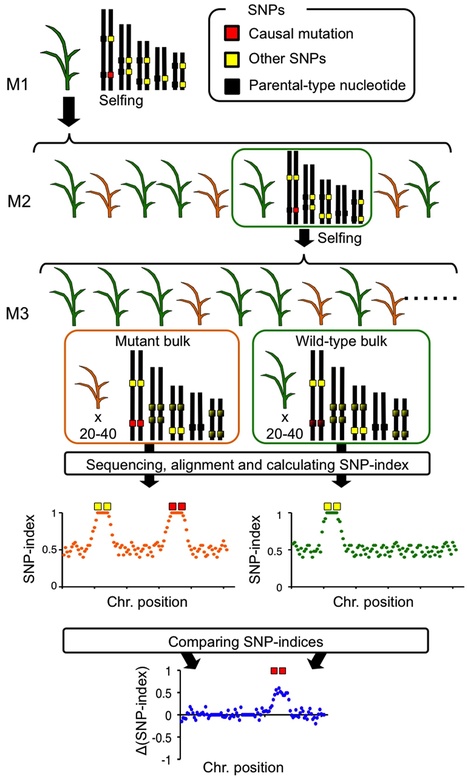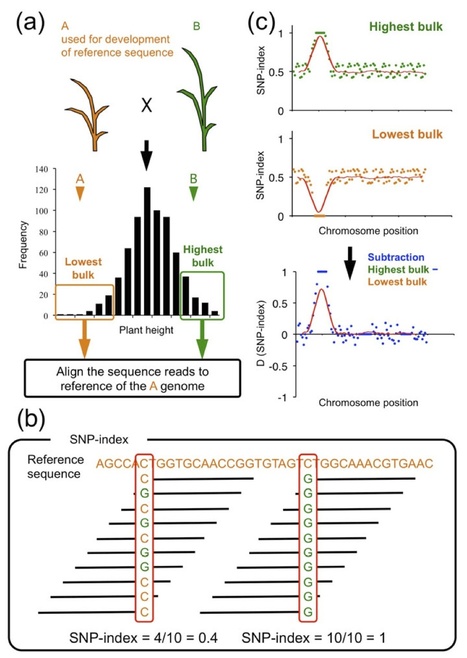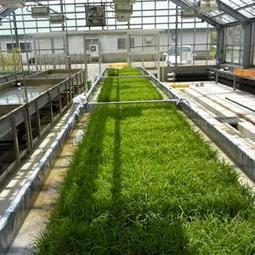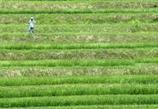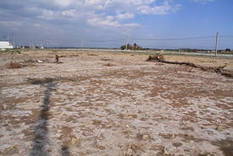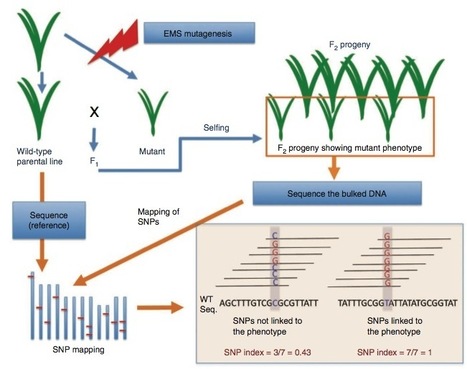 Your new post is loading...
 Your new post is loading...

|
Scooped by
Kamoun Lab @ TSL
March 23, 2015 6:53 PM
|
Following the 2011 earthquake and tsunami that affected Japan, >20,000 ha of rice paddy field was inundated with seawater, resulting in salt contamination of the land. As local rice landraces are not tolerant of high salt concentrations, we set out to develop a salt-tolerant rice cultivar. We screened 6,000 ethyl methanesulfonate (EMS) mutant lines of a local elite cultivar, 'Hitomebore', and identified a salt-tolerant mutant that we name hitomebore salt tolerant 1 (hst1). In this Correspondence, we report how we used our MutMap method to rapidly identify a loss-of-function mutation responsible for the salt tolerance of hst1 rice. The salt-tolerant hst1 mutant was used to breed a salt-tolerant variety named 'Kaijin', which differs from Hitomebore by only 201 single-nucleotide polymorphisms (SNPs). Field trials showed that it has the same growth and yield performance as the parental line under normal growth conditions. Notably, production of this salt-tolerant mutant line ready for delivery to farmers took only two years using our approach.

|
Scooped by
Kamoun Lab @ TSL
June 26, 2013 6:40 AM
|
Next-generation sequencing allows the identification of mutations responsible for mutant phenotypes by whole-genome resequencing and alignment to a reference genome. However, when the resequenced cultivar/line displays significant structural variation from the reference genome, mutations in the genome regions missing from the reference (gaps) cannot be identified by simple alignment.Here we report on a method called ‘MutMap-Gap’, which involves delineating a candidate region harboring a mutation of interest using the recently reported MutMap method, followed by de novo assembly, alignment, and identification of the mutation within genome gaps.We applied MutMap-Gap to isolate the blast resistant gene Pii from the rice cv Hitomebore using mutant lines that have lost Pii function.MutMap-Gap should prove useful for cloning genes that exhibit significant structural variations such as disease resistance genes of the nucleotide-binding site-leucine rich repeat (NBS-LRR) class.

|
Scooped by
Kamoun Lab @ TSL
March 3, 2012 6:25 AM
|
A team of Japanese researchers has developed a method that combines crossbreeding with next-generation sequencing to speed up the identification of genes that cause agronomically important traits in mutant crop lines. The researchers described the method, called MutMap, in a study published in Nature Biotechnology last month. They also outlined their use of the method to rapidly identify the locations of genes associated with desirable traits in mutants of an elite rice cultivar. MutMap combines a strategy of cross-breeding a mutant plant with a desirable trait back to its wild-type parent with whole-genome sequencing of a sample of bulked DNA from several of the resulting crossbreeds. The method's simplicity and efficiency relative to previous methods could help accelerate the improvement of rice and other crops through genomic marker-assisted selective breeding, the group reported. Ryohei Terauchi, the team's leader, told In Sequence that marker-assisted selection has become more and more widespread in crop breeding, but it remains challenging to locate markers for agronomically important traits like yield, flowering time, plant height, and biomass.

|
Scooped by
Kamoun Lab @ TSL
January 31, 2012 5:11 AM
|
From today's paper: Hardier and more productive strains of rice are being developed faster than ever. Today, around 3.5 billion people will sit down to a meal of something and rice. The “something” will depend on whether it’s Jamaica, Shanghai or Kerala, but rice is one of the world’s constants. It is a staple food for nearly half the globe and provides a fifth of all the calories humanity consumes. It is hard to overstate its importance. And that importance is growing: the world’s population, which swept past seven billion last year, is projected to reach nine billion by 2050. How are we going to feed all those new mouths?

|
Scooped by
Kamoun Lab @ TSL
January 28, 2012 10:56 AM
|
Japan is still struggling to recover from the devastation caused by the Tōhoku earthquake and tsunami that hit the country last March. One of the long-term problems is reclaiming farmland ravaged by the tsunami.

|
Scooped by
Kamoun Lab @ TSL
January 28, 2012 11:09 AM
|
Scientists in Britain and Japan have unveiled a fast-track way towards breeding crops with higher yields or resistance to climate change.

|
Scooped by
Kamoun Lab @ TSL
January 28, 2012 10:52 AM
|
Späte folgen bringt der Tsunami des letzten Jahres für die japanischen Reisbauern mit sich: Das Salz des Meereswassers lässt die Pflanzen nicht mehr richtig wachsen. Wissenschaftler haben nun eine neue Methode präsentiert, die rascher zu salzresistenten Sorten führen könnte.

|
Scooped by
Kamoun Lab @ TSL
January 28, 2012 10:51 AM
|
Meriveden suolaamilla riisipelloilla Japanin tsunamialueella kasvanee piakkoin suolaa sietäviä riisilajikkeita. Japanilais-brittiläinen tutkimusryhmä on kehittänyt jalostusmenetelmän, jolla kasveista voidaan eristää haluttu ominaisuus – vaikkapa suolankestävyys – huomattavasti aiempaa nopeammin.

|
Scooped by
Kamoun Lab @ TSL
January 28, 2012 11:01 AM
|
Sono state ottenute piante di riso resistenti al sale e adatte alle risaie giapponesi che lo tsunami del marzo 2011 ha inondato di acqua e fanghi salati, rendendole inadatte alla coltivazione. Il risultato, descritto su Nature Biotechnology, si deve a un gruppo di ricerca giapponese e britannico dell'Iwate Biotechnology Research Centre. Le piante sono state ottenute grazie a un nuovo metodo chiamato Mut Map, che permette di ottenere le piante con le caratteristiche desiderate in modo piu' veloce.

|
Scooped by
Kamoun Lab @ TSL
January 28, 2012 12:26 PM
|
Los investigadores han desarrollado un método, MutMap, para seleccionar semillas de alto rendimiento en un tiempo récord. Aumentan las mutaciones genéticas y sólo requieren una sola unión para aislar las nuevas variedades.
|

|
Scooped by
Kamoun Lab @ TSL
July 11, 2013 3:05 AM
|
Advances in genome sequencing technologies have enabled researchers and breeders to rapidly associate phenotypic variation to genome sequence differences. We recently took advantage of next-generation sequencing technology to develop MutMap, a method that allows rapid identification of causal nucleotide changes of rice mutants by whole genome resequencing of pooled DNA of mutant F2 progeny derived from crosses made between candidate mutants and the parental line. Here we describe MutMap+, a versatile extension of MutMap, that identifies causal mutations by comparing SNP frequencies of bulked DNA of mutant and wild-type progeny of M3 generation derived from selfing of an M2 heterozygous individual. Notably, MutMap+ does not necessitate artificial crossing between mutants and the wild-type parental line. This method is therefore suitable for identifying mutations that cause early development lethality, sterility, or generally hamper crossing. Furthermore, MutMap+ is potentially useful for gene isolation in crops that are recalcitrant to artificial crosses.

|
Scooped by
Kamoun Lab @ TSL
January 12, 2013 3:14 PM
|
The majority of agronomically important crop traits are quantitative, meaning that they are controlled by multiple genes each with a small effect (quantitative trait loci: QTL). QTL mapping and isolation is important for efficient crop breeding by marker-assisted selection (MAS) and for a better understanding of the molecular mechanisms underlying the traits. Since it requires the development and selection of DNA markers for linkage analysis, QTL analysis has been however time consuming and labor intensive. Here we report a rapid identification of plant QTL by whole genome resequencing of DNAs from two populations each composed of 20-50 individuals showing extreme opposite trait values for a given phenotype in a segregating progeny. We propose to name this approach QTL-seq as applied to plant species. We applied QTL-seq to rice recombinant inbred lines (RILs) and F2 populations and successfully identified QTL for important agronomic traits, such as partial resistance to the fungal rice blast disease and seedling vigor. Simulation study showed that QTL-seq is able to detect QTL over wide ranges of experimental variables, and the method can be generally applied in population genomics studies to rapidly identify genomic regions that underwent artificial or natural selective sweeps.

|
Scooped by
Kamoun Lab @ TSL
February 6, 2012 12:36 PM
|
With advances in a technique known as fast-track breeding, researchers are developing crops that can produce more and healthier food and can adapt and thrive as the climate shifts.

|
Scooped by
Kamoun Lab @ TSL
January 28, 2012 10:58 AM
|
Scientists merge traditional crop breeding with modern genomics to make a new salt-resistant rice plant.

|
Scooped by
Kamoun Lab @ TSL
January 28, 2012 10:55 AM
|
Scientists are developing a salt-resistant variety of rice. The move was prompted, in part, by last year's Japan tsunami, which flooded some 20,000 hectares of rice paddies.

|
Scooped by
Kamoun Lab @ TSL
January 28, 2012 11:07 AM
|
Ni OGM, ni processus classique de sélection par croisements successifs: des chercheurs ont dévoilé dimanche une technique révolutionnaire pour produire en un temps record des semences à fort rendement ou résistantes au changement climatique.

|
Scooped by
Kamoun Lab @ TSL
January 28, 2012 11:02 AM
|
A method for marker-assisted breeding, conceived in 2009 through a collaborative research project between the UK and Japan, is now focused on developing rice breeds tolerant to salt-sodden Japanese soils following the Tsunami last year.

|
Scooped by
Kamoun Lab @ TSL
January 28, 2012 10:50 AM
|
Des chercheurs ont développé une méthode, MutMap, permettant de sélectionner des semences à forts rendements en un temps record. Ils dopent les mutations génétiques et n’ont besoin que d’un seul croisement pour isoler les nouvelles variétés.

|
Scooped by
Kamoun Lab @ TSL
January 28, 2012 11:05 AM
|
A tavalyi japán földrengés, illetve az azt követő szökőár nemcsak a városi infrastruktúrát, hanem a mezőgazdasági területeket is károsította. A helyzetet tovább súlyosbítja, hogy Japánban a termőterület mérete alacsony, a szökőár által elmosott szántóföldeketet viszont a sós tengervíz megművelhetetlenné tette. Az ehhez hasonló mezőgazdasági katasztrófák után a termőtalajnak körülbelül tíz évre van szüksége a regenerálódáshoz, a gazdáknak pedig olyan haszonnövényekkel kell kísérletezniük, amelyek sós talajban is képesek növekedni.

|
Rescooped by
Kamoun Lab @ TSL
from Publications
January 28, 2012 10:48 AM
|
The majority of agronomic traits are controlled by multiple genes that cause minor phenotypic effects, making the identification of these genes difficult. Here we introduce MutMap, a method based on whole-genome resequencing of pooled DNA from a segregating population of plants that show a useful phenotype. In MutMap, a mutant is crossed directly to the original wild-type line and then selfed, allowing unequivocal segregation in second filial generation (F2) progeny of subtle phenotypic differences. This approach is particularly amenable to crop species because it minimizes the number of genetic crosses (n = 1 or 0) and mutant F2 progeny that are required. We applied MutMap to seven mutants of a Japanese elite rice cultivar and identified the unique genomic positions most probable to harbor mutations causing pale green leaves and semidwarfism, an agronomically relevant trait. These results show that MutMap can accelerate the genetic improvement of rice and other crop plants.
|



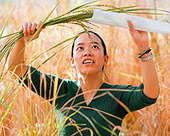


 Your new post is loading...
Your new post is loading...

